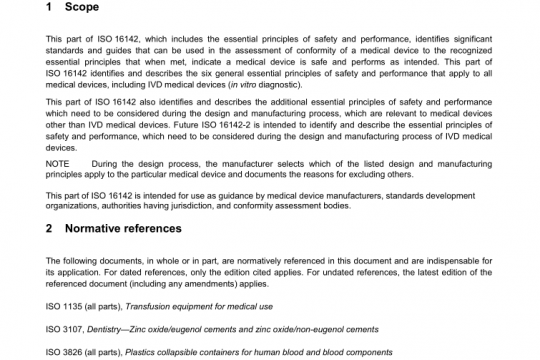ANSI AAMI ST50 pdf free download
ANSI AAMI ST50 pdf free download.Dry heat (heated air) sterilizers.
2 Normative references 2.1 NATIONAL FIRE PROTECTION ASSOCIATION. National Electrical Code. ANSI/NFPA 70:2002. Quincy (MA): NFPA, 2002. American National Standard. 2.2 UNDERWRITERS LABORATORIES. Electrical equipment for laboratory use—Part 1: General requirements. UL 61 01 0A-1 . Northbrook (IL): UL, 2002. 3 Definitions of terms For the purposes of this standard, the following definitions apply. 3.1 accuracy: Extent to which the measured value of a quantity differs from the true value of the quantity measured. 3.2 bioburden: Population of viable microorganisms on a product and/or package. NOTE—When measured, bioburden is expressed as the total count of bacterial and fungal colony-forming units per single item. 3.3 biological indicator (BI): Microbiological test system providing a defined resistance to a specified sterilization process. NOTE—Biological indicators are intended to demonstrate whether or not the conditions were adequate to achieve sterilization. A negative BI does not prove that all items in the load are sterile or that they were all exposed to adequate sterilization conditions. 3.4 certification: Formal report of test results attesting to the satisfactory performance of a sterilizer and accompanied by a statement to this effect signed by the manufacturer’s authorized representative. 3.5 certified laboratory standards: Standards traceable to the National Institute for Standards and Technology (NIST) or other recognized industry or government standards. 3.6 chamber: Portion of a sterilizer in which items are processed and that is sealed off from the ambient environment during the sterilization cycle when the door is closed.3.7 chemical indicator (CI): System that reveals change in one or more predefined process parameters based on a chemical or physical change resulting from exposure to a process. NOTE—Chemical indicators are intended to detect potential sterilization failures that could result from incorrect packaging, incorrect loading of the sterilizer, or malfunctions of the sterilizer. The “pass” response of a chemical indicator does not prove that the item accompanied by the indicator is sterile. 3.8 contaminated: State of having been actually or potentially in contact with microorganisms. NOTE—As used in health care, the term generally refers to microorganisms that could be capable of producing disease or infection. 3.9 control set temperature: Arbitrary temperature that serves as the operating reference for the sterilizer control system so that the chamber temperature will remain within the required range around the selected sterilization exposure temperature. 3.10 control system (sterilizer): System that regulates the sterilization conditions within a sterilization chamber. 3.11 culture: A growth of microorganisms in or on a nutrient medium; to grow microorganisms in or on such a medium. 3.12 culture medium: Substance or preparation used to grow and cultivate microorganisms. 3.13 cycle time reduction value: Time required to kill 90 % of spores on a biological indicator when the biological indicator is placed in a test pack. 3.14 D value: Time or radiation dose required to achieve inactivation of 90 % of a population of test microorganisms under stated exposure conditions. NOTE 1 —The larger the D value, the more resistant the microorganism is to destruction. The D value can be derived by plotting the logarithm of the number of microbial survivors against sterilization exposure time; the time corresponding to a 1 -logarithm reduction in numbers can then be directly measured. NOTE 2—For purposes of this standard, “radiation dose” does not apply.ANSI AAMI ST50 pdf download.
Other IEC Standards
-

ANSI AAMI ISO 16142-1 pdf free download – non-IVD medical devices and guidance on the selection of standards
AAMI standards list DOWNLOAD -

ANSI AAMI ISO 16142-2 pdf free download – General essential principles and additional specifc essential principles
AAMI standards list DOWNLOAD


